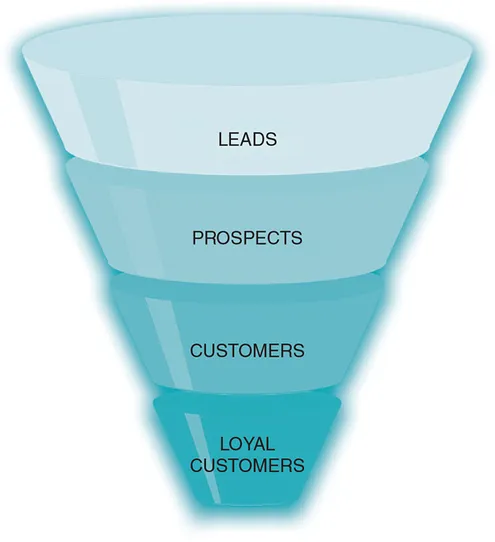Today’s modern selling still follows an ordered process which is aligned with the sales funnel (also called ‘sales cycle’), which is a graphic that shows that many prospective buyers enter the sales cycle as sales leads; fewer of these progress to prospects once their needs/wants are qualified; and even a smaller number convert to customers once they make the buying commitment (see Figure 1.1). We’ll examine the sales funnel more closely in Chapter 4. In addition, we’ll overview the stages of the selling process later in this chapter and cover each of them in great depth throughout the chapters of this book. Today’s selling process is enabled by digital tools and techniques that make the progression much more efficient, effective, and satisfying for both the buyer and the seller. Digital technology not only enables salespeople to more precisely target prospective buyers, but it empowers those buyers with information and education so that they remain in the driver’s seat. Indeed, the modern selling process has evolved over the decades into a rewarding and fulfilling activity for all parties involved.
Understanding the importance of relationships in selling
Successful selling is not about what is sold or bought, it’s about satisfying people’s needs, wants, and desires. Selling is about solving people’s problems. They aren’t likely to let you do that unless you develop a good relationship with them and earn their trust. If you truly want to be a part of the problem-solving team, then you have to accept the problems of your customers or your prospective customers (also called ‘prospects’) as your problems. So, in essence, this is a book about how to communicate and really connect with other people, earn their respect and trust, and help to solve their problems by satisfying their needs, wants, and desires. Keep in mind that only relationships built in an ethical manner, with strong integrity will become productive and long term. We’ll address the crucial topic of ethics in greater detail later in this chapter, as well as throughout the entire book, but first, let’s explore the origins of selling.
Think back to the old days before the invention of modern machinery, communications systems, and modes of transportation beyond horses – that’s when selling actually began. Selling started in the form of bartering, where one entity would produce some goods or services of value and would exchange those for the valuable goods or services generated by another entity. These bartering exchanges would satisfy the needs or wants of each party and in the end, the problems of all of the entities would be solved. In those early days, all transactions occurred face to face, likely with the reputations of each individual well established and known by all who engaged in buying and selling exchanges. Back then, if you didn’t keep your word, nobody would trade with you. Thus, buying and selling began with the best intentions and integrity. Although our modern world has transformed the simple bartering exchange process, successful selling remains rooted in strong moral convictions and ethical practices.
Today’s selling is aided by sophisticated databases and analytical tools to help salespeople zero in on those prospective buyers who have a need, want, or problem with which the salesperson can assist. Digital, mobile, text, and social media have led many people to believe that in-person selling is passé – that personal contact is an antiquated notion. However, this is far from the truth. Person-to-person selling puts a friendly, human face on today’s digital business world. Think of it this way: a company may create the most brilliant marketing campaign, the cleverest advertisements, the catchiest tweets, and a ‘wow’ of a website to sell its excellent, need-satisfying products and services, but to land that client account or sell those products or services, its salespeople must come out from behind their desks or laptops and engage with real human beings on a meaningful level. That’s where personal selling kicks in.
Personal selling is the interpersonal communication between sellers and buyers or prospective buyers in the exchange of products, services, or something of value, to the mutual benefit of both parties. Personal selling is a feature of the traditional promotional encounter which may take place face to face, by telephone, or via digital channels, such as email, social media, and online conferencing.2 Some people stereotypically think of personal selling as ‘the art of persuading people to buy.’3 While persuasion indeed is an important aspect of selling, it does not always lead to mutually satisfying relationships in the long run. Unfortunately, in the past, some overzealous salespeople have used their persuasive talents to be able to ‘make a sale’ in order to reach a designated sales quota determined by their sales manager. Those situations frequently lead to dissatisfied customers with zero repeat sales potential. Salespeople who are adept at convincing prospects to buy given products/services will only achieve long-term successful customer relationships if they ensure that the products/services being purchased will truly satisfy their customers’ needs/wants and solve their problems. Thus, while the ability to persuade is a good skill for salespeople to develop, it can be misused and detrimental when salespeople lack integrity.
Salesperson persuading a prospect
The golden rule in selling today is: Don’t make a sale, create a customer! Just think about what this saying implies – a sale is just one transaction, but a customer, once created, will potentially purchase from you and your company many times over the years, and if earned, become brand loyal to your company for a lifetime of patronage. Transactional selling, which is a form of selling that focuses solely on completing a deal, is rarely used in today’s business world. Rathe...








